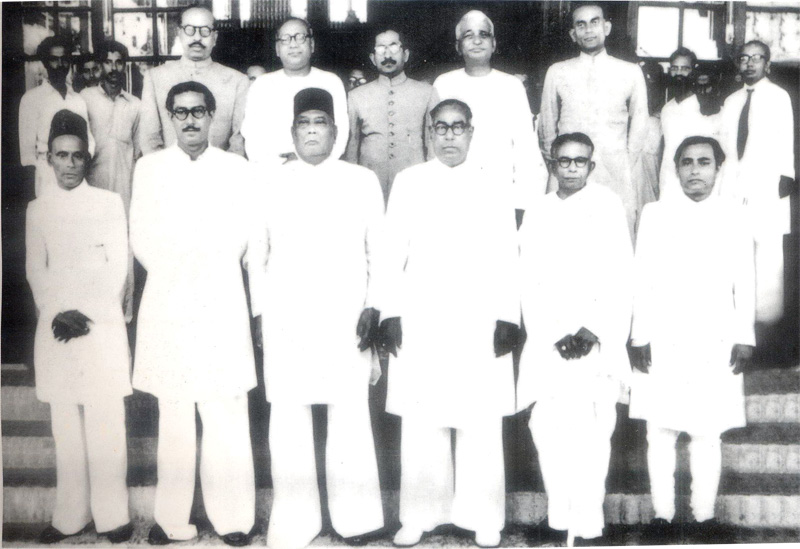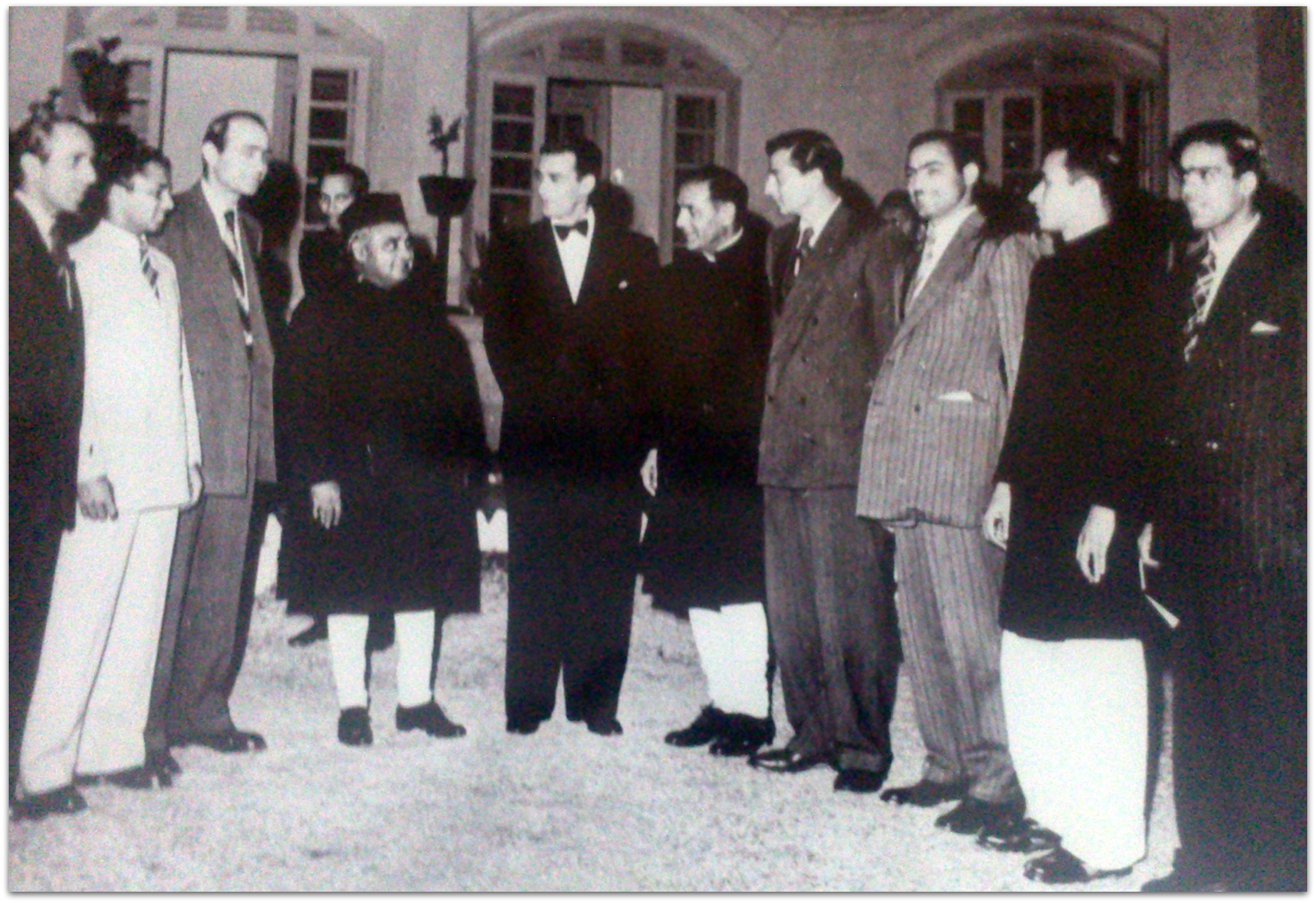|
Ataur Rahman Khan (other)
Ataur Rahman Khan (; 6 March 1905 – 7 December 1991) was a Bangladeshi lawyer, politician and writer, who served as the chief minister of East Pakistan from 1 September 1956 – March 1958, and as the prime minister of Bangladesh from 30 March 1984 to 1 January 1985. Early life Ataur Rahman Khan was born on 1 July 1905 at Balia village, Dhamrai Thana, Dhaka District, East Bengal, British India. He graduated from Pogose School in Dhaka in 1924. He then graduated from Jagannath College in 1927. He obtained a bachelor's degree in economics and law from the University of Dhaka in 1930 and 1936 respectively. Career Khan joined the Dhaka District Bar in 1937. He then joined the judicial branch of the Civil Service as a munsiff in 1942 where he worked until 1944. He joined the Krishak Praja Samiti and served as the secretary of the Dhaka District unit. In 1944, he joined the All India Muslim League. He served as the vice president of the Manikganj unit of the Muslim League ... [...More Info...] [...Related Items...] OR: [Wikipedia] [Google] [Baidu] |
Prime Minister Of Bangladesh
The prime minister of Bangladesh (, : Bāṅlādēśēr Prôdhānmôntrī), officially prime minister of the People's Republic of Bangladesh (, : Gôṇôprôjātôntrī Bāṅlādēśēr Prôdhānmôntrī), is the head of government of the Bangladesh. The prime minister and the cabinet are collectively accountable for their policies and actions to the Parliament, to their political party and ultimately to the electorate. The prime minister is ceremonially appointed by the president of Bangladesh. The position was taken over by the military during the years of 1975–78, 1982–86 and 1990–91 due to imposed martial law. In each of these periods, the national government leadership was controlled by the military with the executive authority of the president and the prime minister. During the period between 1996 and 2008, the chief adviser of the caretaker government exercised authority as per the constitution as chief executive for 90 days during the transition from one ele ... [...More Info...] [...Related Items...] OR: [Wikipedia] [Google] [Baidu] |
Jatiya League
The Jatiya League, officially Bangladesh National League, which was founded as the National Progressive League, and later known as the Pakistan National League, is a dissolved political party in Bangladesh. Ataur Rahman Khan was the leader of the party. Later it was granted registration in Bangladesh on 21 September 1976. Notable members *Ataur Rahman Khan *Oli Ahad Oli Ahad ( – 20 October 2012) was a Bangladeshi politician and language activist of the Language Movement. He was awarded The Independence Day Award in 2004 by the Government of Bangladesh. Early life Ahad was born in to a Bengali family in ... References Defunct political parties in Bangladesh Political parties established in 1968 Political parties disestablished in 1984 Awami League breakaway groups 1968 establishments in East Pakistan {{Bangladesh-party-stub ... [...More Info...] [...Related Items...] OR: [Wikipedia] [Google] [Baidu] |
Jagannath College
Jagannath University (JnU) () is a public university located in Sadarghat, Dhaka, Bangladesh. Founded as ''Dhaka Brahma School'' in 1858 and renamed ''Jagannath School'' in 1872, and later renamed ''Jagannath College'' in 1884, the institution was taken over by the Pakistani government in 1968, while Bangladesh was still a part of Pakistan. It opened graduate and post-graduate programmes in 1975 and was approved as a full public university in 2005. In 2022, Jagannath University opened its first residential hall, for female residents only. The university is in the southern part of Dhaka city near the River Buriganga and a new campus of approximately 81 ha (200 acres) is being built at Keraniganj. Total campus area is more than 85 ha (210 acres) with three campuses and a women's residence hall. History Dinanath Sen, Prabhaticharan Roy, Anathbandhu Mallik, and Brajasundar Kaitra founded Dhaka Brahma School in 1858, and the university's history began there. The name J ... [...More Info...] [...Related Items...] OR: [Wikipedia] [Google] [Baidu] |
Pogose School
Pogose Laboratory School and College, IER, Jagannath University () was established in Dhaka on June 12, 1848, as the first private school of the country by Armenians, Armenian merchant Nicholas Pogose, who was an ex-student of Dhaka Collegiate School. It is located at Chittaranjan Avenue. The school was managed as a proprietary institution and in 1871, about a year after the death of Pogose, it was taken over by Mohini Mohan Das, a banker and zamindar. After the death of Das in 1896 his estate kept the school open. History According to historian Muntasir Mamun, Pogose Laboratory School and College, IER, Jagannath University started in 1848. It was also found that the school may have started a few years earlier as 99 students were suspended due to their inability to pay extended fees. After that the principal at the time, Dr. A.T. Wise, opened a school named Union School. It was created mainly for poor and underprivileged students, with Pogose taking it over two years later at his o ... [...More Info...] [...Related Items...] OR: [Wikipedia] [Google] [Baidu] |
East Bengal
East Bengal (; ''Purbô Bangla/Purbôbongo'') was the eastern province of the Dominion of Pakistan, which covered the territory of modern-day Bangladesh. It consisted of the eastern portion of the Bengal region, and existed from 1947 until 1955, when it was renamed as East Pakistan. East Bengal had a coastline along the Bay of Bengal to the south, and bordered India to the north, west, and east and shared a small border with Burma (presently known as Myanmar) to the southeast. It was situated near, but did not share a border with Nepal, Tibet, the Kingdom of Bhutan and the Kingdom of Sikkim. Its capital was Dacca, now known as Dhaka. The Partition of India, which Partition of Bengal (1947), divided Bengal along religious lines, established the borders of the Muslim-majority area of East Bengal. The province existed during the reign of two monarchs, George VI and Elizabeth II; and three Governor General of Pakistan, governors-general, Muhammad Ali Jinnah, Khawaja Nazimuddin and ... [...More Info...] [...Related Items...] OR: [Wikipedia] [Google] [Baidu] |
Dhaka District
Dhaka District () is a Districts of Bangladesh, district in central Bangladesh, and is the densest district in the nation. It is a part of the Dhaka Division. Dhaka, the capital of Bangladesh, rests on the eastern banks of the Buriganga River which flows from the Turag River, Turag to the southern part of the district. The former Dhaka City Corporation, Dhaka city corporation occupied only about a fifth of the area of Dhaka district until 2011 where the municipal corporation was fractionated and rearranged in Dhaka North City Corporation, North and Dhaka South City Corporation, South corporations due to being the economic, political and cultural centre of the district and also the country. Dhaka District consists of Dhaka, Dhaka city, Keraniganj Upazila, Keraniganj, Nawabganj Upazila, Dhaka, Nawabganj, Dohar Upazila, Dohar, Savar Upazila, Savar and Dhamrai Upazila, Dhamrai upazila. Dhaka District is an administrative entity, and like many other cities, it does not cover the mode ... [...More Info...] [...Related Items...] OR: [Wikipedia] [Google] [Baidu] |
Dhamrai Thana
Dhamrai () is an upazila of Dhaka district in Dhaka division, Bangladesh. It is the largest upazila in the district by land area. Geography Dhamrai upazila is located about 40 kilometers northwest of the capital city of Dhaka. It is bounded by the upazilas of Mirzapur and Kaliakair on the north, Singair on the south, Savar in the east, and Manikganj Sadar, Saturia and Nagarpur on the west. The total area of the upazila is 307.41 km2. Dhamrai upazila is composed of the alluvium soil of the Bongshi and Dhaleshwari rivers. Other rivers are Kolmai and Gazikha History There are two theories on the naming of Dhamrai. The first is that during the time of Ashoka, there was a Buddhist called Dharmarajika and that the area was named after him. The discovery of a Buddhist stupa in Savar, about 10 miles from Dhamrai, lends credence to this opinion. Another theory is that in the early fourteenth century, five companions of the Sufi saint Shah Jalal (Tirmidhi Al-Husayni, Haji, Ghaz ... [...More Info...] [...Related Items...] OR: [Wikipedia] [Google] [Baidu] |




